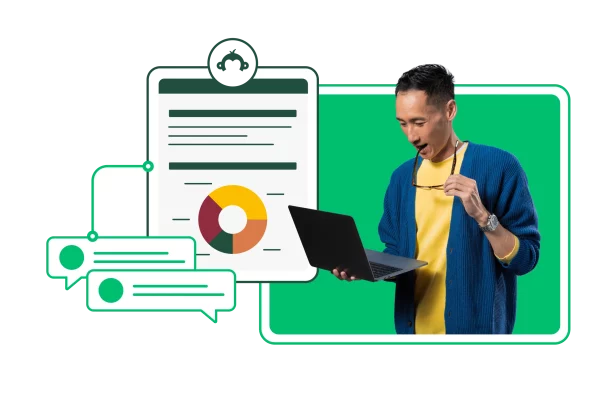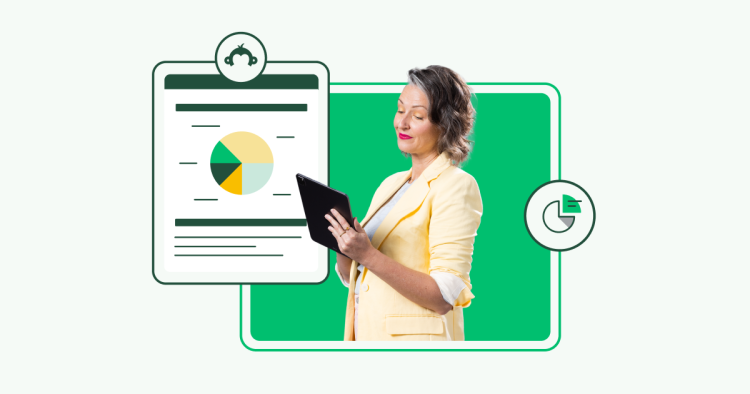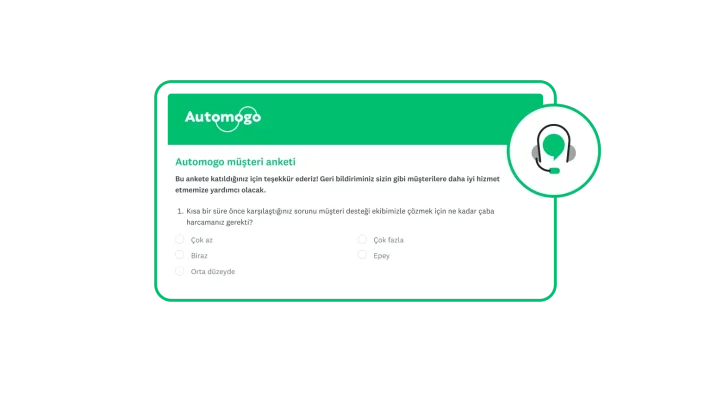Müşteri ve pazar araştırması için odak grupları ve anketler

İster rekabete ilişkin görüşler arıyor ister müşteri sadakatini artırmaya çalışıyor olun, sahip olabileceğiniz en değerli araçlardan biri müşteri geri bildirimleridir.
Neden mi? Müşteri geri bildirimleri neyi doğru, neyi yanlış yaptığınızı anlamanıza yardımcı olur ve iyileştirmeniz gereken konular hakkında size bilgi verir. Fakat müşteri geri bildirimlerini toplamak için farklı yöntemler vardır. Daha açık ifade etmek gerekirse, odak grupları ile anketler arasında bir seçim yapmanız gerekecektir.
Karar vermenize yardımcı olmak için odak gruplarının ve anketlerin avantaj ve dezavantajlarını gösteren ve ek olarak müşteri görüşleriniz için hangisini ne zaman kullanmanız gerektiğini açıklayan bir kılavuz hazırladık.
Odak grubu nedir?
Araştırmacılar bir odak grubu oluştururken dikkatli bir şekilde belirli bir hedef pazarı veya kullanıcı profilini temsil eden birkaç kişi seçerler. Odak grubu çalışması sırasında araştırmacılar sorular sorarak grubun katılımcılarıyla bir tartışma ortamı yaratır. Odak grubu çalışmaları genellikle etkileşimli bir şekilde yapılır ve insanların size gerçekten ne düşündüklerini rahatça söyleyebilecekleri tarafsız bir ortamda gerçekleştirilir.
Odak grupları, tanımı gereği kesin sonuçlara dayalı nicel araştırma verilerinden ziyade keşif amaçlı nitel görüşler sağlamak üzere tasarlanır. Bunun nedeni büyük bir veri kümesini analiz etmiyor olmanızdır. Bunun yerine kullanıcıların fikirlerini, bakış açılarını ve kişisel hikayelerini ya da anekdotlarını dinlersiniz. Bu sayede müşterilerinizin deneyimi veya hedef pazarınız hakkında daha kapsamlı bir fikir edinebilirsiniz ancak elde ettiğiniz bilgiler size ulaşmaya çalıştığınız geniş kitle hakkında kesin kanıtlar sunmayacaktır.
Yine de bir odak grubundan elde edeceğiniz veriler, müşterilerinizin ne düşündüğü ve neden böyle düşündüğü konusunda size değerli görüşler sağlayabilir. Bu araştırma yöntemi sayesinde pazarınıza uygun bir ürün geliştirebilir, ilgi çekici pazarlama kampanyaları oluşturabilir veya pazardaki değişimlere uyum sağlayabilirsiniz.
Anket nedir?
Anketler bir örneklemden geri bildirim toplamak için kullanılan araştırma yöntemidir. Genellikle nicel araştırma kapsamında değerlendirilirler ve odak grubundan farklı olarak sonuçlar kesin olabilir.
Anketler soru sormanızı ve herhangi bir şeyi ölçmenizi sağlar. Tek bir soru kadar kısa veya yüzlerce soru kadar uzun olabilir. Yanıt biçimlerine çoktan seçmeli yanıtlar, değerlendirme ölçekleri ve açık uçlu metinler örnek olarak verilebilir.
Anketler bütçe ve zaman açısından büyük esneklik sunar. Öte yandan, bir anket çalışması yürütmeye başladığınızda çok fazla değişiklik yapmamanız gerektiği için bu yöntem esnek olmama özelliği de taşıyabilir. Doğru veriler toplamak için sorularınızın tutarlı olması gerekir.

Odak grupları mı anketler mi? Hangisi ne zaman kullanılmalı?
Bir odak grubu veya anket seçmeden önce araştırma sorularınızı yazın. Ardından bu sorular hakkında daha fazla soru sorun. Başka bir deyişle, bu araştırmayı yürütmek için ne tür bilgilere ihtiyaç duyacağınızı düşünün.
- Tek yönlü sorularla tatmin edici yanıtlar alabilir misiniz yoksa sohbet ederek ilerlemek daha mı iyi olur?
- Daha fazla açıklama gerektirebilecek bir konsepti veya kullanıcı deneyimini test etmek istiyor musunuz?
- Katılımcıların tepkilerini doğrudan gözlemlemek istiyor musunuz?
- Sadece birkaç görüşe dayanarak karar verme konusunda endişeleriniz var mı?
- İstatistiksel olarak anlamlı sonuçlar elde etmek için daha büyük bir örnek boyutundan geri bildirim almanız gerekiyor mu?
Müşterileriniz veya hedef pazarınız hakkında daha fazla bilgi sahibi olmak için bir odak grubu oluşturabilirsiniz. Onları nelerin motive ve memnun ettiğini ya da ne gibi sorunlar veya sıkıntılar yaşadığını öğrenin. Bu görüşler sayesinde yeni ürün veya hizmetleriniz için gerekli bilgiler toplayabilir, rekabete ilişkin görüşler edinebilir veya Müşterinin Sesi programınızı daha etkili hale getirebilirsiniz.
Anketler genellikle belirli olaylarla bağlantılıdır ve verileri analiz ederek kuruluşunuz için hedefe yönelik belirli iyileştirmeler yapabilirsiniz. Örneğin, destek ekibinizle iletişime geçen tüm müşterilere bir müşteri hizmetleri geri bildirim anketi gönderebilirsiniz. Aldığınız geri bildirimler önemli müşteri hizmetleri metriklerini takip etmenize ve hedefe yönelik iyileştirmeler yapmanıza yardımcı olabilir.

Odak gruplarının ve anketlerin avantajları ve dezavantajları
Odak grubu mu yoksa anket mi kullanmanız gerektiğinden hala emin değil misiniz? O halde müşteri veya pazar araştırmanız için hangisini kullanmanız gerektiği konusunda size yardımcı olabilecek aşağıdaki listeyi inceleyebilirsiniz.
Odak grupları
Avantajlar
- Müşteri geri bildirimlerini müşterilerinizin kendi ağzından dinleyebilirsiniz.
- Şirket içi ekibinizin dikkate almamış olabileceği ancak müşteriniz için önemli olan fikirleri ve sorunları keşfedebilirsiniz.
- Tartışma sırasında konuları daha ayrıntılı inceleme esnekliğine sahip olabilirsiniz.
- Belirli takip soruları sorarak müşteri geri bildirimlerini netleştirme olanağı.
Dezavantajları
- Masraflar arasında katılımcı bulma, tesis kiralama, moderatör ve/veya ajans ücretleri, katılıma ilişkin ödeme, grupları görmek için birden fazla yere yapılan seyahatler ve daha fazlası yer alabilir.
- Grup tartışmasında baskın olan açık sözlü katılımcılar nedeniyle sonuçlarda sapmalar olabilir.
- Zaman gerektiren bir iş olması nedeniyle nitelikli katılımcı bulmakta zorluk çekebilirsiniz.
- Planlama, organizasyon, katılımcı bulma ve (muhtemelen) seyahat gibi konularda önemli ölçüde zaman ve çaba harcamanız gerekir.
Anketler
Avantajlar
- Hızlı bir şekilde geri bildirim alabilirsiniz. Yanıtlayan sayısına bağlı olarak, sonuçları 24-48 saat içinde alabilirsiniz.
- Yapacağınız araştırmayı bir kez tasarlayıp anketinizi gönderdikten sonra zaman içinde aynı anketi tekrar gönderebilirsiniz. (Ayrıca bu sayede kıyaslama yapmak ve sonuçları takip etmek kolaylaşır.)
- Anketinizde isimsiz yanıtlara izin veriliyorsa katılımcılar daha rahat bir şekilde samimi geri bildirimde bulunabilirler.
- Aynı anda birden fazla müşteri türüne ulaşabilir ve verileri herhangi bir değişkene göre ayrıntılı olarak inceleyebilirsiniz.
Dezavantajları
- Müşteri ve pazar araştırması yaparken, müşterilerin iletişim bilgilerine sahip değilseniz katılımcı bulmakta zorlanabilirsiniz.
- Takip soruları sorarak müşteri geri bildirimlerine açıklık getiremezsiniz.
- Katılımcılar ankette yer almayan konular hakkında proaktif olarak geri bildirim sağlama imkanına sahip olmayabilir.
- Anket uzunluğu önemli olduğu için sorabilecekleriniz sınırlıdır. İnsanların uzun anketlere dikkatli ve eksiksiz yanıt verme olasılığı daha düşüktür.
Her iki araştırma türü için de benzer hazırlıklar yapmanız gerekecektir.
Bir odak grubu veya anket çalışması nasıl başarılı bir şekilde yürütülür?
1. Hedefler belirleyin
Anketinizi yazmadan veya odak grubunuzu oluşturmadan önce araştırmanız için bir hedef belirlemeniz gerekir. Hedefiniz ilerlemek veya bir karar vermek için ne yapmanız gerektiğini ortaya koyar.
Hedefinizi veya hedeflerinizi (aşırıya kaçmadan!) yazarak anket veya odak grubu sorularınızı daha iyi hale getirebilirsiniz. Her iki durumda da anketinizi yanıtlayanlar ve odak grubu katılımcılarınız bundan memnuniyet duyacaktır.
Ayrıca hedeflerinizi belirlediğinizde, araştırmanızın şirket hedefleriyle veya ilgili KPI'larla uyumlu olmasını da sağlayabilirsiniz. Gerçek anlamda faydalı bilgiler sağlayacak sorular sorduğunuzdan emin olmak için şirket içindeki önemli paydaşlarla iş birliği yapmak da iyi bir fikirdir.
2. Katılımcılar bulun
Anketinizi kimlerin yanıtlamasını veya odak grubunuza kimlerin katılmasını istiyorsunuz? Aynı derecede önemli olmak üzere, kimleri hariç tutmak istiyorsunuz?
Katılımcılarınız araştırmanızın başarıya ulaşmasında önemli bir rol oynar. Dolayısıyla yaş, cinsiyet, hane geliri, meslek ve katılımcılarınızın yaşadığı yer dahil olmak üzere demografik verileri göz önünde bulundurmanız gerekir.
Katılımcıların iletişim bilgilerine sahip misiniz yoksa hedef pazarınızda anket yapmanıza yardımcı olacak bir araştırma grubuna mı ihtiyacınız var? Katılımcıların ürününüzü veya ürün kategorinizi tanımasını mı istiyorsunuz?
Anketinize katılacak doğru kişileri bulmak için yardıma ihtiyacınız varsa SurveyMonkey Audience belirttiğiniz özelliklere göre dilediğiniz herkesle iletişime geçebilir.
3. Bir odak grubu tartışma kılavuzu hazırlayın
Tartışma kılavuzu moderatörün odak grupları için kullandığı bir senaryo gibi düşünülebilir. Tartışma kılavuzu konuşmanın çerçevesini çizer, tartışmayı yönlendirir, hedefleri ele alır ve tüm katılımcıların konuya dahil olmasını sağlar. Tartışma kılavuzu oluşturmadan önce aşağıdaki sorulara açıklık getirin:
- Moderatörün ne tür sorular sormasını istiyorsunuz?
- Moderatör, katılımcıların sorularını yanıtlayabilmek için projeniz hakkında ne bilmeli?
- Bir konsepti veya prototipi test ediyorsanız moderatörün katılımcılara verebileceği ipuçları neler?
- Moderatörün doğru takip soruları sorabilmesi için araştırma hedefleriniz hakkında ne bilmesi gerekiyor?
Bir araştırmacıyla çalışıyorsanız kuruluşunuzun hedefleriyle uyumlu olması gereken odak grubu hedeflerinizi ve amaçlarınızı belirleyerek başlayın. Soruları doğru şekilde sorduğunuzdan ve grup katılımcılarını çok fazla konu veya istekle sıkmadığınızdan emin olmak için bu araştırmacıyla ortak çalışma yürütün.
4. Anket sorularını iyi yazın
Anket oluşturuyorsanız iyi anket soruları yazmak ve sık yapılan anket hatalarından kaçınmak için aşağıdaki en iyi uygulamalara uyun:
- Yönlendirici ve yüklü sorulardan kaçının
- Çift yönlü sorular sormayın
- Hassas anket soruları sorarken dikkatli olun
- Açık ve anlaşılır bir dil kullanın
- Doğru soru türünü kullanın
Hedefinizden sapmamaya özen gösterin. Hedefiniz sorduğunuz soruları şekillendirir. İster işlemlerle veya müşteri ilişkileriyle ilgili bir anket hazırlıyor olun ister kapalı uçlu veya açık uçlu soruların sayısını dengelemeye çalışıyor olun, aklınızda daima belirlediğiniz hedef olsun.
Güvenilir anketler ve sorular oluşturmak için hala yardıma ihtiyacınız varsa uzmanlar tarafından yazılmış anket şablonlarımızı kullanabilirsiniz. Dilerseniz istek metninizi alıp sizin için tüm anketi yazabilen yapay zeka destekli anket uzmanımız SurveyMonkey Genius'a da göz atabilirsiniz.
5. Odak grubu katılımcılarının hazırlıklı olması gerektiğini unutmayın
Verimli bir odak grubu görüşmesi için katılımcı hazırlığının önemli olduğunu unutmayın. Katılımcı hazırlığı sayesinde katılımcıların kafasında belirli beklentiler oluşacağı için katılımcılar grup görüşmelerine rahat ve öz güvenli bir şekilde katılabilirler.
Katılımcı hazırlığı aşağıdakileri kapsayabilir:
- Odak grubu çalışmasının yeri, zamanı ve süresinin paylaşılması
- Katılımcıların tartışma konuları hakkında bilgilendirilmesi
- Gizlilik anlaşmaları da dahil olmak üzere her türlü kural veya ilkenin açıklanması
Katılımcıların araştırma başlamadan önce herhangi bir faaliyeti veya görevi yerine getirmesi gerekiyor mu? Odak grubu çalışmasından önce katılımcıları bilgilendirmek için bir telefon görüşmesi planlamayı veya bir e-posta göndermeyi düşünebilirsiniz.
6. Ödeme yapmak için bütçe ayırın
Müşteri katılımını teşvik etmenin avantaj ve dezavantajlarını değerlendirin. Katılımcılara ayırdıkları zaman için ne kadar ödeme yapabilirsiniz? Bir saat veya daha fazla süren uzun anketler veya odak grubu çalışmaları için hediye kartı vermeyi düşünebilirsiniz.
Ne kadar para teklif ettiğiniz konusunda dikkatli olmanız gerektiğini unutmayın. Bu miktar çok fazla olursa insanlar nitelikli olmasalar dahi anketinizi yanıtlayabilir veya odak grubunuza katılabilir. Vereceğiniz miktar çok az olursa da insanlar size dikkatli bir şekilde yanıt vermek için motive olmayabilir.
Odak grupları ve anketler hakkında son düşünceler
Genel olarak belirtmek gerekirse, müşterilerinizle yön belirlemenize yardımcı olacak bir görüşme yapmak istiyorsanız odak grubu yöntemini kullanabilirsiniz. Elinizde iyi belirlenmiş sorular varsa ve büyük bir gruba veya birden fazla müşteri grubuna ulaşmanız gerekiyorsa doğru seçim anket olacaktır.
Neyse ki her proje için tek bir yöntem seçmek zorunda değilsiniz. Anketlerden ve odak gruplarından elde ettiğiniz görüşler birbirini tamamlayabilir. Anketler size sonuç çıkarmak için ihtiyaç duyduğunuz nicel verileri ve istatistiksel olarak anlamlı sonuçları sağlayabilir. Diğer yandan odak grupları ise pazarınızın veya müşterilerinizin sesine kulak vermenizi sağlayarak verilerinizin ardındaki "neden" sorusunu yanıtlayabilir.
Hedef pazarınızı güvenle araştırın
Odak grubu veya anket çalışması yapmaya hazır mısınız? SurveyMonkey pazar araştırmanızı destekleyebilir. Reklamları ve yeni konseptleri test etmek, marka sağlığınızı izlemek ve rekabete ilişkin görüşler elde etmek bunlardan sadece birkaçı. Hedef pazarınıza ulaşma konusunda daha fazla bilgi edinin.
Diğer kaynakları keşfedin

Marka Pazarlama Müdürü
Marka pazarlama müdürleri, hedef kitlenizi anlamak, markanızı büyütmek ve yatırım getirisini (ROI) kanıtlamak için bu araç takımından faydalanabilir.

Tüketici ürün ve hizmetlerine yönelik SurveyMonkey çözümlerini keşfedin
Tüketici ürünleri ve hizmetleri sektörü sıradaki adımlarını şekillendirecek görüşler almak için SurveyMonkey'den yararlanıyor.

Perakende sektörüne yönelik SurveyMonkey çözümlerini keşfedin
Trendleri yakalamak, başarılı ürünler geliştirmek ve sevilen markalar yaratmak isteyen perakende şirketleri SurveyMonkey'den nasıl yararlanıyor?

Profesyonel hizmet firmalarına yönelik SurveyMonkey çözümlerine bakın
Profesyonel hizmet kuruluşlarının müşteri ve pazar görüşleri elde etmek için SurveyMonkey'i nasıl kullandığını öğrenin.